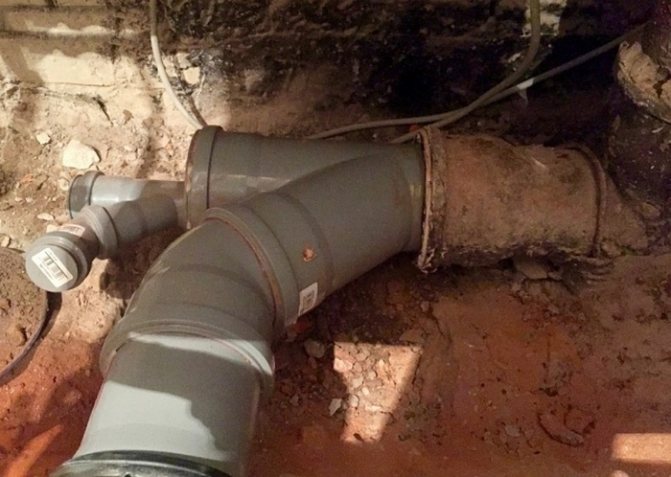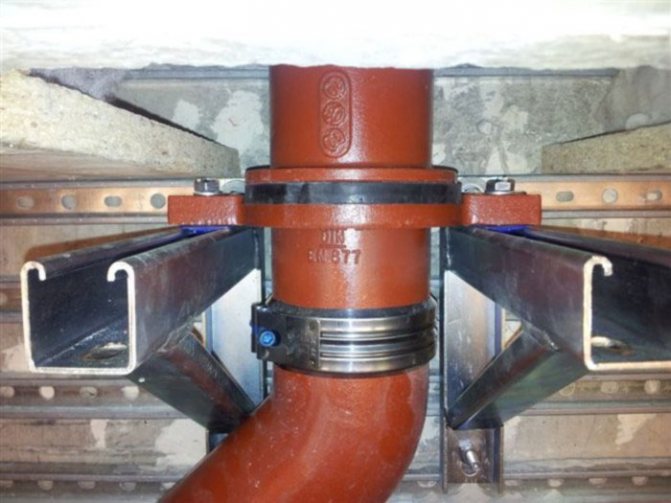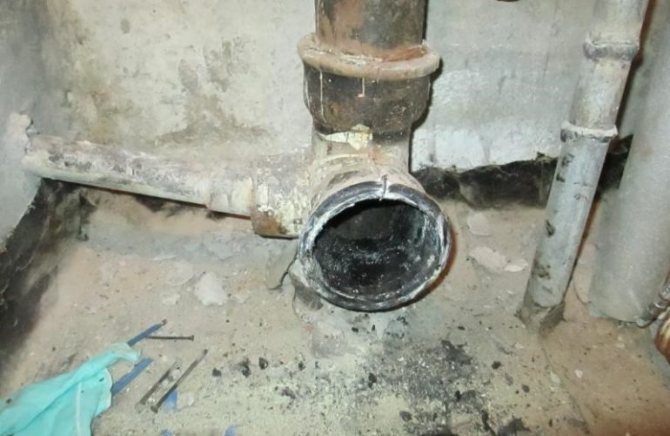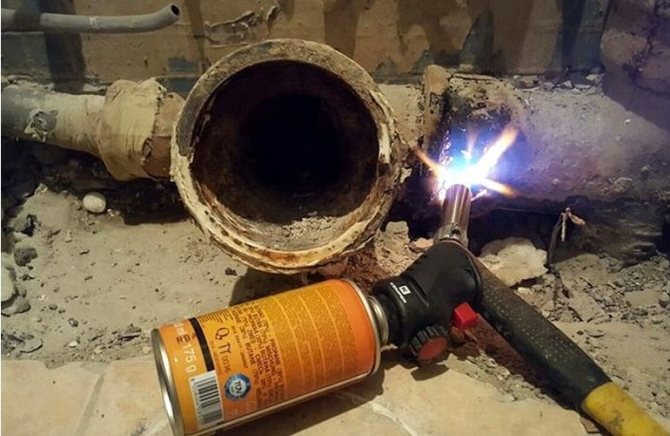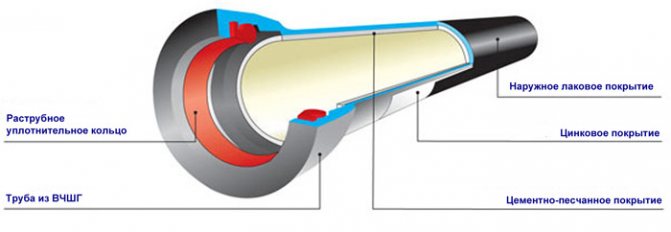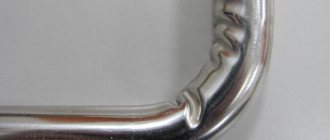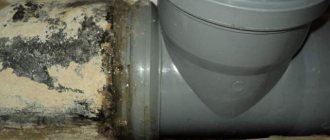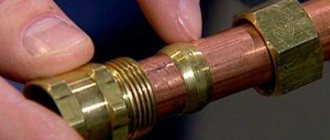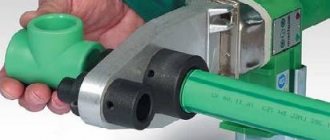Sewerage
Author Irina Luneva
the date
Aug 31, 2016
0
4 461
Share this
Cast iron pipes are capped when dismantling or repairing a worn-out sewer system. The technology of caulking depends on the method of joining the joints (type of filling): cement ones are carefully broken with a hammer, filled with hot sulfur are heated with a blowtorch. It is more difficult to disassemble an old cast-iron sewer system than a recently assembled one, since over the years it rusts and the thickness of deposits increases. In any case, it is laborious the process, cast iron, for all its merits, belongs to brittle materials and splits under direct application of force.
The most difficult thing is to disconnect the cast-iron sewer pipes at the joints of apartment wiring and common house risers; without work experience, it is better to entrust these areas to specialists
- Start and sequence of repair
- How to avoid problems
- Embossing cast-iron pipe
Cast iron pipes
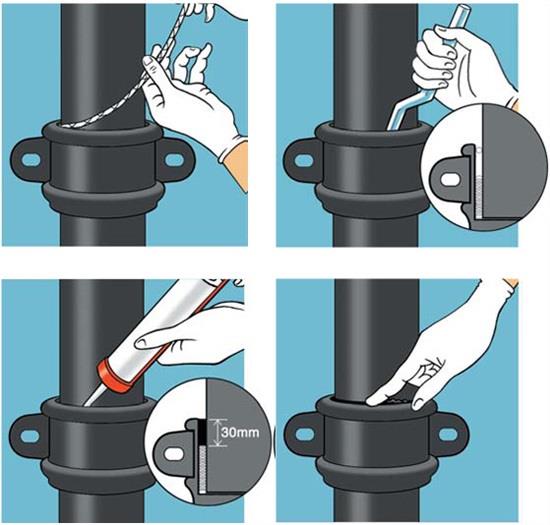
In the case of replacing such plumbing equipment as a toilet bowl or a sewer riser, it is necessary to very carefully perform the procedure for capping cast-iron pipes first of all. With strict adherence to all the rules for capping or capping connected sewer pipes, it is possible to perform such work with your own hands.
Do-it-yourself technology for caulking cast-iron sewer pipes in 5 simple steps


Cast iron pipes are capped when dismantling or repairing a worn-out sewer system. The technology of caulking depends on the method of joining the joints (type of filling): cement ones are carefully broken with a hammer, filled with hot sulfur are heated with a blowtorch. It is more difficult to disassemble an old cast-iron sewer than a recently assembled one, since over the years it rusts and the thickness of deposits increases. In any case, it is laborious the process, cast iron, for all its merits, belongs to brittle materials and splits under direct application of force.
Decompression is performed in the following order
At first, it is necessary to very carefully, without undue effort, tap the socket part of the sewer pipe with a hammer in order to avoid a complete replacement of the riser section in case of cracking. By loosely loosening the pipe to be dismantled, it is necessary to make sure that the socket can freely move and rotate on the sides and that it can be gradually released from embossing with a cable. Now you can dismantle it in the following order: • loosen the bell in all directions; • little by little pull the rope and pick it out with a thin straight object with a screwdriver or some kind of rod; • the rope must be gripped firmly with pliers; • continue to gently loosen it and gently pull on the rope.


The ineffectual tapping and immobility of the bell indicate that the caulking was carried out using a special sulfur filling. In this case, it is necessary to perform the direct burning procedure according to the following scheme:
• it is necessary to carefully warm up the socket section of the cast-iron pipe in a circle using a blowtorch or a gas burner, while remembering to continue to loosen, twist and tap the socket section of the pipe;
• after it has moved from the place of the old embedment, it is necessary to continue to loosen it with the help of any tool, an adjustable wrench, etc. After dismantling, it is necessary to thoroughly clean the socket using any cutting tool of a knife, chisel or chisel.When stripping, special attention should be paid to the socket seat, on which the sealing rubber will subsequently be installed. Place a lubricated rubber seal ring in the cleaned socket. Install the required assembly into the seal.
Coin options
In order to firmly and hermetically construct a sewer system from cast-iron pipelines and parts to it, it is imperative to provide for the correct option to seal the gap that forms between filling the void between the pipes, which is always shown when butt-joining the inner socket part of the pipe with its outer surface part. It should be noted that the choice of the necessary consumables, the appropriate special tools for carrying out sealing work and the amount of time spent depend on the method of sealing the connection of cast iron pipes. It is proposed to consider the currently existing two options for stamping cast-iron connections. 1. The first option is the use of cement mortar
The procedure for sealing pipe joints with a cement mortar consists of the following steps: • In the formed gap between the pipes, it is necessary to lay a special tarred sealant. To perform such a gasket, a conventional bundle previously tarred in a special solution is used, which is hammered into the formed gap between the pipe and the socket to a depth equal to 2/3 of the gap space. After creating the first sealing ring, it is necessary to put the end of the rope (harness) on top of this ring so that it does not end up inside the pipe to be installed. • Next, you should seal the remaining part of the gap depth (1/3 of the remaining space) between the pipes with a prepared cement mortar, which has already been compacted with a tarred band. In order to increase the density and reliability of the caulking of the joints, it is required to use a special chasing in conjunction with a hammer, with which it is necessary to carefully tamp the cement mortar. The moment of the end of the embossing is the beginning of the rebounds of the embossing from the clogged cement seal. In order to obtain a high-quality setting of the cement mortar, it is necessary to cover the compacted area with a wet cloth, for example, gauze. • In order to prepare the cement mortar, you will need to purchase cement grade 300400. It must be mixed with water in a ratio of 9/1. • It is possible to increase the speed of work during caulking with the help of such special tools as broadened chasing and caulking. In this case, the course of the entire process is accelerated by 30%. • If the work is carried out in winter at low ambient temperatures, then the cement mortar in this case must be mixed in heated water, and in this case, it is imperative to temporarily insulate the cement-sealed pipe joint.
2. The second option is the use of asbestos cement


This process is slightly different from the previous one and has its own procedure: • It is necessary to knead the asbestos fiber in a dry state with cement in a ratio of 1/2, respectively; • The collected dry mix should be kneaded in water before using as a seal between pipes. The volume of water in the solution should be about 1012% of the total volume of the mixture being prepared. • The process of hammering the gap between the pipes is carried out in the same way in accordance with the established procedure for the first option for sealing connections.
A procedure such as caulking or caulking connections between cast-iron pipes has its own difficulties and difficulties with its own nuances and tricks. Therefore, in order to achieve a positive result with such laborious work, it is recommended to seek help from knowledgeable and experienced professionals.In this case, there is a guarantee that you can get rid of unnecessary hassle and costs in case of unplanned replacement of risers as a result, for example, of unsuccessful tapping with a hammer of the socket part of the sewer pipe.
Methods for capping pipes and options for neutralizing it
Embossing a pipe, that is, connecting its elements, can be done in three ways. Moreover, each of them requires its own specific approach.
Nowadays, in order to connect the elements, it is not at all necessary to stamp a pipe. This can be done using a special adapter sleeve. Moreover, such an element can connect pipes made of various materials, for example, cast iron and plastic.
Embossing of pipes can be made from different materials. Various pipe punching and ways to eliminate it:
- It will be easiest to separate the elements if they have been capped. This is a rope that is wound around pipes and compacted. To check if this method has been used, you need to hit the bell several times with a rubber hammer, and then try to loosen it. If the pipe yields, then most likely the cable was used. In this case, you need to pick out the top layer of the rope with a screwdriver, find its end and pull it out. Throughout the entire work, it is necessary to gently loosen the pipe. Stagger it until it is possible to pull out the required element. If the bobbin was covered with cement mortar from above, then it must first be knocked down. To do this, a screwdriver is placed on it at an angle, which is tapped.
- During the Soviet era, the bobble was rarely used. Sulfur was much more common. In this case, you will have to do a rather dangerous job. For her, you will definitely need to wear a gas mask, because sulfur vapors will be released, which are extremely poisonous. It is also necessary to air the apartment. So, it is necessary to melt the sulfur with a blowtorch so that it becomes a liquid state. When heating, it is periodically necessary to tap the pipe until a noticeable stirring appears. When the pipe itself heats up, it will need to be taken with an adjustable wrench and pulled with effort. This will free the required element.
This is how pipes are punched out. It is worth noting that the gray option is the most dangerous. Therefore, if you do not have a gas mask or a special construction respirator, then it is better not to start at all.
Diy embossing of a cast-iron sewer pipe
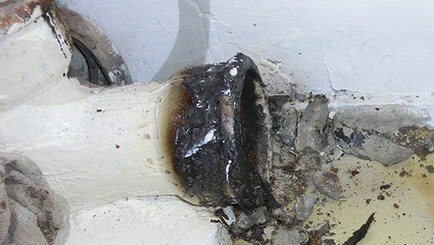

Almost all Soviet buildings are equipped with cast-iron sewer lines, since such pipes are durable and resistant to wear and tear. But cast iron piping requires the right approach to use and dismantle.
Unlike sewer pipes, which can last for decades, connections within a home may need to be replaced sooner. Also, interventions in the sewer system may be forced when installing washing equipment or redeveloping a bathroom. To do it according to the rules, it is not necessary to call and wait for the master, all the work can be mastered by the owner himself, if he knows how to handle elementary tools. Dismantling the sewer should not take much time, but dismantling old products is more difficult. Let's figure out how to properly dismantle cast iron pipes.
Step-by-step caulking of cast iron pipes
In the process of repairing sewer communications with your own hands, the most difficult moment may be the embossing of a cast-iron pipe. Such manipulation may be required when repairing or reinstalling the riser. In this case, it is necessary to very carefully emboss the nipples of the cast iron pipes. This work can be done in stages like this:
- First, use a hammer to lightly tap the bell, while acting carefully so as not to break it, since negligence can lead to irreversible consequences, for example, replacing the entire riser. Better to use a wooden mallet.
- If the previous blockage was made with a cable, then after tapping, the bell should wobble freely and can be removed without additional effort. If so, do the following:
- swing the bell from side to side;
- pry with a screwdriver and pull the rope a little;
- hook it with pliers;
- slowly and carefully pull out the rope, swinging the pipe in the process.
- If, after tapping, the pipe did not start moving, it means that the previous caulking of the sockets of the sewer pipes was carried out by pouring sulfur. In this option, you will need to get rid of it by burning it out. To do this, proceed as follows:
- gently heat the pipe at the joint along the entire diameter with a blowtorch or torch;
- lightly, trying not to break the walls of the pipe, then tap it with a hammer;
- if the bell begins to wobble, try moving it using an adjustable wrench.
Please note that when working with a burner and sulfur, it is imperative to protect the respiratory tract with a mask so as not to get poisoned by poisonous fumes.
- After successful dismantling, the walls of the socket must be well cleaned with a chisel and chisel. Pay special attention to the flare seat as this is where you will place the sealing rubber.
- Having previously coated the rubber seal with a special lubricant, place it in the socket.
- Place a new structural member in the rubber ring.
Cast iron disassembly moments
With a complete replacement of the structure with a plastic one, you can not do unnecessary work and just break everything with a hammer. This is quite easy to do, because cast iron is considered a brittle material. However, if only part of the pipeline is to be disassembled, the work must be done more carefully.
Before dismantling the cast iron sewer, you need to inspect the entire system to determine the area that will be repaired. Then the water supply must be turned off so that the drains do not fall into the sewer. Further disassembly is carried out in stages:
- The part of the pipe below the joint is cut off.
- The pipe is disconnected with a socket. The capping methods will be discussed in more detail.
- If the connection does not come out just like that, use a blowtorch or make the surrounding cuts 20 mm long.
When carrying out the procedures, it is imperative to use all protective equipment due to the injury hazard of this work.
Caulking pipe with sulfur connection
Regardless of what the cast-iron sewer was connected with, before replacing it, it is imperative to carry out some standard preparatory work:
- turn off the water;
- disconnect the hose leading to the toilet;
- remove the toilet itself by unscrewing the bolts;
- clean the bathroom from appliances and furniture.
To determine if sulfur was actually used when connecting the pipes, you need to bring a blowtorch to the seam. Under the influence of high temperatures, sulfur melts, accompanying this process with an unpleasant odor.
When disassembling cast-iron sewer pipes, work begins from the farthest corner. The element must be broken with a hammer. It is better to use a tool with a plastic or polymer base, because metal nozzles can clog the sewage system. Having found the cross leading to the riser, it is necessary to loosen it as much as possible.
Then you need to prepare a blowtorch or a gas burner. At least two people should be involved in heating the compounds. While one heats up and melts the sulfur, the other must loosen the structure. In this case, it is imperative to use gloves and other protective equipment.
When the joint is completely melted, the crosspiece can be removed from the riser.In this case, you should be very careful, you must remember to remove the remaining sulfur, and then let the riser cool down thoroughly. If the cast iron structure is too strong, you can always make a few cuts near the pipe to be removed. This will facilitate the extraction procedure.
Expansion of a pipeline with a cement joint
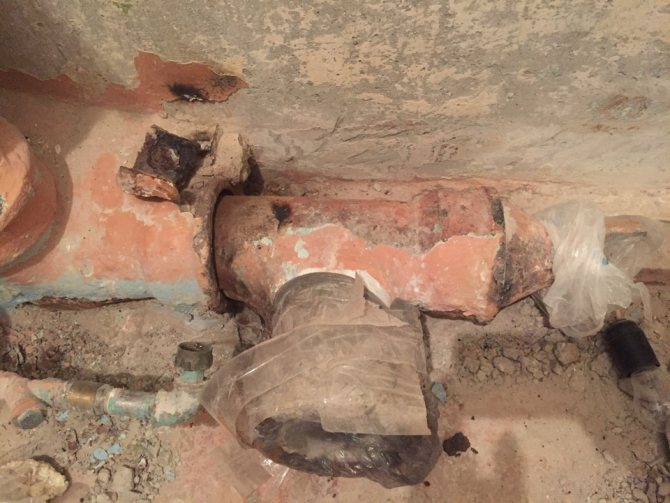

Dismantling cast iron pipes that have been connected with cement is practically the same as the above-mentioned option with sulfur, however, it is much safer. This is because when sulfur melts, a lot of carbon monoxide is released.
To start dismantling, you need to cut off part of the pipe. In this case, it is worth retreating at least 30 cm from the junction. The frozen cement is removed with a hammer, which must be hit on a screwdriver or chisel inserted into the hole. All procedures should be performed as carefully as possible so as not to damage the socket.
When the joints are free of cement, try to loosen the main pipe. In order not to process the sewer with a blowtorch or a torch, it is necessary to remove the cable, but if this cannot be done without it, it is necessary to heat it strongly or use a specialized wrench. For example, for a 50 mm pipe, use tool # 3 and # 4.
The cross is located at the bottom of the main riser. To remove it, you can simply use a hammer and screwdriver. In this case, for some time, you need to lightly tap on the tee itself in order to form a small gap between it and the branch pipe. Then you need to penetrate this opening, pry on the tee and remove it. It will take a lot of time to carry out these manipulations, in addition, this method can be ineffective.
The next option is to use a blowtorch or torch. Dismantling is much faster, but the payment for this is an unpleasant odor that takes a long time to disappear. First of all, you need to cut off the socket of the cross. Then a heating device is placed in the pipe. A metal shield is applied to the upper part of the pipe in order to be able to regulate the draft inside the riser. When heating, you need to start swinging the pipe and, as soon as possible, remove the dismantled tee.


You can also use a grinder. To do this, you must first cut off the parts of the tee, leaving a small piece in the pipe. Then put a medium-sized disc that could freely get inside, and cut through the remaining parts of the structure with a grinder, knocking them out with a hammer.
Precautions in the repair of cast iron pipes
When working with such pipes, be sure to remember that cast iron, with its endurance, is a relatively fragile material. If you hit with a metal hammer harshly or too hard, the wall vibrates and cracks may appear. If this happens, replacing the damaged sections will be time consuming and costly. Therefore, when preparing for dismantling, stock up on the necessary tools in advance.


It is not worth working alone, it is unsafe and difficult. Better call someone for help.
It is important to know that sulfur fumes can be harmful to health, so use a gas mask, as a last resort, a respirator and goggles. Also, take care of good air circulation in the room where renovation work is taking place.
After removing the pipe from the socket, take the time and attention to clean the seat of that part. This will ensure the installation of the sealing material without defects and distortions.
All dismantled material and garbage should be immediately packed into construction bags, tied up and thrown away. An unpleasant odor will be emitted from the old pipeline.
If you are embossing cast iron pipes for the first time and after reading this article, you still do not understand how to do this, be sure to contact a professional.For an experienced craftsman, the process of dismantling cast iron pipes will take 25-30 minutes, while a beginner can spend more than 3 hours and with an unknown result.
Some precautions
When working with cast iron pipes, one should not forget about their relative fragility: from sharp and strong blows of a metal hammer, vibrations and, as a result, cracks can occur in the pipe. Then replacing defective segments will turn into an endless and expensive process.
It is necessary to work with a grinder in goggles and a respirator. This prevents metal debris from getting into the eyes and respiratory tract. In order to avoid micro-injuries of the hand, it is recommended to protect it with work gloves
Before starting the caulking, make sure that all the necessary materials and tools are available.
Guided by the above description, having a good command of his own hands and having an idea of what chasing is, a man can repair or re-equip sanitary-technical communications in the house on his own, without the involvement of a specialist. There would be a desire!
Selection of sealant for sewer cast iron pipes
It is necessary to seal the joints of the sewer cast-iron pipe dia. - 120mm with sockets. The house is wooden there is a movement of the foundation, I tried to wrap the joints with fiberglass with cement mortar. It costs several years, then the connections on the site with a minimum slope begin to undermine. Of the materials now there is fiberglass and asbestos cord without impregnation. Please recommend a good quality, flexible, high adhesion sealant for the job.
Polyurethane roofing sealant.
Remark, re-emboss with gray filling.
ssrr, thanks for the recommendation. While it is not possible to find a polyurethane sealant in Kostroma, there is only silicone and acrylic. We found Sazilat-51 in two-component buckets of 15 kg., We are looking further ... stager, if possible, describe briefly your method of sealing with sulfur filling. Earlier I believed that the joint, sealed with one gray, is very hard and brittle. Filling is only possible with a vertical pipe. How is it possible to seal joints using sulfur on a horizontal section of pipes?
Hmm. IMHO - no need to invent a bicycle. Mark with a bobble. Cover with cement mortar. Paint the seam with Kuzbass varnish. To avoid ground movements, make a sand cushion. Or, as an option, to refuse minting as such. And try to pick up the rubber cuffs.
gayanovv wrote: IMHO. Mark with a bobble. Cover with cement mortar. Paint the seam with Kuzbass varnish. To avoid ground movements, make a sand cushion.
Thanks for the suggested option. The joints were sealed with asbestos cord + cement mortar on top. The house is wooden, a horizontal section of the sewer runs through the whole house in the basement, the pipes lie without pillows, right on the sandy ground. After a few years, some of the joints began to undergo digging, apparently due to shrinkage of the house and / or movement of the ground. Will PU sealant with asbestos and fiberglass stand better in these conditions compared to embossing with bob or not? The cost of the sealant in this case is secondary.
gayanovv wrote: Or, try to pick up rubber cuffs.
Rubber specialized cuffs are available for cast iron pipes dia. 120 mm? To install them, it will be necessary to disassemble the entire pipe section. If the connection is more durable and reliable, it will be possible to sort out the pipes.
DICOM wrote: Rubber specialized cuffs are available for cast iron pipes dia. 120 mm?
you can try to stretch (with soap) 123/110 cast iron / plastic. There are also round thick rings for HTUGs.
IMHO, find the bobbin and stamp, wrap the joint with Guerlain tape on top. It will be forever. Guerlain is:
DICOM wrote: A quality, flexible, high adhesion sealant for the job.
You can also manage to score a joint with them. but it is sticky
DICOM wrote: Thanks for the suggested option. The joints were sealed with asbestos cord + cement mortar on top. The house is wooden, a horizontal section of the sewer runs through the whole house in the basement, the pipes lie without pillows, right on the sandy ground. After a few years, some of the joints began to undergo digging, apparently due to shrinkage of the house and / or movement of the ground. Will PU sealant with asbestos and fiberglass stand better in these conditions compared to embossing with bob or not? The cost of the sealant in this case is secondary.
Rubber specialized cuffs are available for cast iron pipes dia. 120 mm? To install them, it will be necessary to disassemble the entire pipe section. If the connection is more durable and reliable, it will be possible to sort out the pipes.
A heel is a strand of linen soaked in iso. butane (you can't pronounce it without half a liter). And, asbestos is easily washed away with water. Maybe that's the reason? Indeed, you can buy ordinary 123x110 cuffs and try to cut them. If it succeeds, it will certainly keep it. IMHO Throwing new plastic pipes will be easier than sorting out cast iron.
gayanovv wrote: it will be easier than sorting through cast iron.
And less deposits in them.
The pipe joints were sealed with polyurethane sealant ISOFLEX P-40 (which I could find in the city) with filler. The sealant is relatively inexpensive, 220 rubles for 600 ml. Hope it lasts a long time. If there are problems, I will replace the cast-iron pipes with plastic ones. Thank you all for your help and recommendations, I learned a lot!
This is how the textbook advises to mint. :
§ 41. Assembly of cast iron pipes with cementing of sockets
Cast iron sewer pipes and fittings are connected by sealing the gap between the inner surface of the bell and the outer surface of the pipe end or fitting inserted into the bell (84). After caulking, a cement mortar is prepared, and then the space left in the socket is sealed with moistened cement and tightly coined with chasing and hammer. To seal the socket, cement grade 300-400 is used, which is thoroughly mixed with water in a proportion of nine parts of cement to one part of water (by weight). The bell is filled with cement mortar using a scoop and coined until the latter begins to bounce off the cement. In order for the cement mortar to set well, it is recommended to cover it with a wet rag at the end of rapping. In hot weather, the cloth should be moistened with water from time to time. The sockets can be caulked and chased with broadened caulkers and chases that cover up to lU of the pipe circumference, due to which the caulking and chasing process is accelerated by 25-30%. In winter, the cement slurry is prepared in hot water, and the sockets are heated. The joints are insulated after sealing. Instead of cement, asbestos cement is used to seal the socket. An asbestos-cement mixture for sealing joints is prepared by mechanical mixing of cement grade not lower than 400 and asbestos fiber (not lower than VI grade) in a ratio of 2: 1. Immediately before sealing each joint, the dry asbestos-cement mixture is moistened by adding 10-12% of water by weight of the mixture. With an asbestos-cement mixture, the joint is sealed at about 7th of the socket height. Then the pipe inserted into the bell of the lower part is centered with three metal wedges so that the width of the annular gap between the pipe and the bell is the same everywhere, and the wedges are driven in with light hammer blows (87, c). To seal the prepared joints, cement is first poured into the vessel for preparing the solution. Vasiliev's device (85, a) consists of a metal plate 7 and a bracket attached to it on the hinge 2.The pipe is pressed against the plate with a bracket and locked with a wedge-shaped check 3, which allows the pipes to be held in an upright position. Kozlov's adaptation (85, b) is more perfect. A carousel stand (86) is also used to assemble assemblies from cast-iron sewer pipes with a diameter of 50 and 100 mm. The carousel has six workstations with pneumatic clamps, each of which can be brought to the collector by turning the table manually. Carousel diameter 2046 mm, height 880 mm.
Section 42. Assembly of cast iron pipes with expansion cement
Sealing the sockets of cast iron pipes with resin strand and cement requires a lot of labor, significant consumption of strands and a long time for the cement to set. In addition, the tightness of the joints depends on the quality of caulking and chasing. First, the necessary pipes and fittings are selected. Then they are cut on a hand press or on a driven machine, parts of the required size are obtained and pipes and fittings are adjusted. After that, clean the joints from dust and dirt with a stiff brush and rinse with water.After the part has been removed from the bath, inventory wedges are knocked out of the joints with light hammer blows, and the holes from them are sealed with a solution of expanding cement. The prepared pipeline units can be sent to the installation sites no earlier than 16 hours after the joints are sealed.
§ 43. Assembly of cast iron pipes with sulfur and lead sealed sockets
Sealing of sockets with gray. Sealing the sockets j of cast-iron sewer pipes with expanding cement requires exposure to cement setting, and, consequently, large areas at assembly plants or CZM. To seal the sockets of cast-iron sewer pipes, industrial sulfur (powder or lumpy) is used. Lumpy sulfur is preliminarily crushed into pieces with a volume of no more than 1 cm3. The joint, sealed with one gray, is very hard and fragile, therefore, when transporting units to construction sites, the tightness of the joints is broken. To make the butt joint soft, add 10-15% of ground kaolin to the sulfur. Before assembling the sewer units, the sulfur together with kaolin are heated in a special bath (88). "! Sulfur is charged through an opening located at the top of the bath. Vapors and gases are also discharged through this opening. The tank 1 for sulfur is mounted inside the bath and is washed by a heating medium - mineral oil 3, which is heated to a temperature of 130-135 ° C by four electric heating elements 4 installed inside the bath. When the temperature rises above 135 ° C, sulfur becomes inactive and brittle when it cools. It is necessary to warm up the sulfur slowly for 1.5-2 hours. The bath is protected by thermal insulation 5. The molten sulfur cannot be stored in the tank for more than 2 hours. The process of sulfur hardening after pouring the sockets takes 5 minutes for pipes with a diameter of 50 and 100 mm, for pipes with a diameter of 150 mm - 10 min. The labor intensity of filling joints with gray compared to filling with expanding cement is reduced by 40%, the cost of sealing by 33%. When working with sulfur, the following safety rules must be observed: the content of sulfur dioxide in the working area should not exceed 0.02 mg / l; the bath for heating sulfur must have local ventilation; flammable materials should not be located near the place where sulfur is heated; the temperature of heating sulfur should not exceed 135 ° С, since at higher temperatures, sulfur ignites in air. If sulfur ignites, it is necessary to stop heating the bath and close it with a lid; burnt sulfur should be extinguished with sand. When laying cast-iron water pipes, the size of the gap between the ends of the smooth end of the pipe and the stop in the socket is recommended to be taken according to table. 16. The joints when laying the pipeline on a straight section of the route must be centered so that the width of the socket slot, taking into account the tolerances for the diameters of the socket and the flanged end of the pipe, is the same along the entire circumference. The joints of bell-shaped cast-iron water pipes are sealed with resin (or bituminized) hemp strand, rubber rings or a rubber cord. The hemp resinous strand is introduced into the socket in succession with three bundles. Each tourniquet is sealed to failure with a blunt caulk.After compaction of the strand, the remaining free space in the annular gap of the socket is coined with asbestos cement, consisting by mass of 30% of asbestos fiber not lower than grade 4 and 70% of cement grade not lower than 400. A gap of 3-10 mm is left between the end of the pipe and the socket to compensate lengthening of pipelines. The dry asbestos-cement mixture for sealing the sockets should be diluted with water (10-12% of the mass of the dry mixture) to make it crumbly. Prepare it immediately before starting work in the amount required to seal one socket. When sealing the joints of bell-shaped cast iron pipes with asbestos cement at an air temperature below -5 ° C, instead of water, 15-17% '(of the mass of the mixture) of fine-crystalline well-crumbling snow should be added to the asbestos-cement mixture. The dry asbestos-cement mixture is cooled to the outside temperature before mixing with snow. It is necessary to prepare an asbestos-cement mixture with snow in such an amount that is necessary for a one-day work. The mixture is supposed to be stored in closed boxes. It is not allowed to use the thawed mixture for sealing joints. Covered joints are covered with wet matting or sprinkled with wet soil and kept wet for at least 4-8 hours for better adhesion. Sealing the sockets of cast-iron water pipes with lead is carried out in the following sequence. First, the inner surface of the bell and the outer end of the pipe to be connected are cleaned, after which the pipe is pushed all the way into the bell and the pipes to be connected are sprinkled with soil. Then, a bituminized strand is introduced into the slot of the socket with bundles and compacted well with caulking. In this way, the socket is filled up to 2/3 of the height. After caulking, a casting mold is formed around the socket joint. To form a shape on the pipe close to the socket, one turn of the rope is made (the diameter of the rope must correspond to the size of the gap), previously coated with liquid clay. Then a clay roller is made around the socket, bringing the ends of the rope outward, after which the rope is pulled out of the roller. Inside a clay roller in the zone of tree plantations and aquifers with a pipe depth of more than 5 m is not allowed.
Capping pipes
When assembling a system consisting of cast iron pipes, a method should be foreseen to seal the gaps that invariably remain between the outer side of the pipe to be inserted and the inner surface of the socket. That is, you should think about how to mint cast iron pipes. There are two possible ways to solve the problem, we will consider them in more detail.
Sealing sockets with a cement mixture
The minting technology looks like this:
- Installing a resin seal.
- caulk the resin rope into the socket to 2/3 of its depth;
- when forming the first rope ring, overlap the end of the rope over the ring so that it does not fall into the pipe.


Minting technology
- Using cement mortar.
- cement marking 300-400 mixed with water (by weight) in a ratio of 9: 1;
- Fill the place in the socket remaining after the harness seal with cement mortar;
- to hammer and hammer the cement tightly until the embossing rebounds from the cement;
- for better gripping of the mortar, cover it with a wet cloth after caulking.
To increase the productivity of the work, it is worth using widened caulking and chasing, which can speed up the process by about 30%.
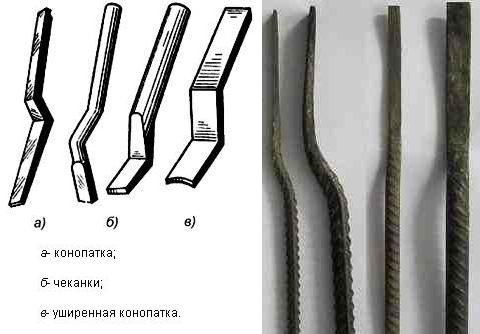

Socket Pipe Sealing Tool
If the work is carried out in winter, the cement should be mixed with hot water, and the joints must be insulated after sealing.
How to stamp a cast iron sewer pipe: stamping and how to stamp an old pipe
Not all users know how to mint a cast-iron sewer pipe. moreover, not everyone knows what it is about. However, during the assembly or reconstruction of the sewer system, the ability to properly mint pipe joints will come in handy.
In many houses, old cast iron pipelines are still preserved, which it is impractical to completely change to modern plastic. The pipes are still strong, capable of working for more than a dozen years. As a rule, they are left intact, replacing only the apartment horizontal wiring sections. Consider how the connection of cast iron pipes is made when installing drainage systems.
Features of cast iron pipes
Cast iron pipes were used everywhere in Soviet times. Alternative materials for manufacturing were used on a limited scale, for the assembly of special sewer lines. The properties of cast iron pipelines allow the old system to work until now. The advantages of these pipelines:
- tendency to corrosion;
- heavy weight;
- fragility, inability to withstand sharp blows;
- the complexity of the assembly.
The most significant drawback is the complicated connection procedure, or the embossing of cast iron sewer pipes. Combined with the heavy weight of the parts that put significant stress on the supporting structures, these drainage lines were difficult to install and maintain. However, the durability and reliability of cast iron systems are appreciated by experts. All networks, the state of which does not inspire concern, are still effectively used for wastewater disposal.
Connection methods
The assembly of cast iron pipelines is a complex and demanding task. There are several types of connections:
- into the bell. This is the most popular type, which is called "caulking of sewer pipes". The process requires accuracy and experience, strict adherence to technology requirements. Correct capping can withstand several decades of leakage operation;
- coupling connection. This option is used for socketless pipes. Special couplings are used that tightly wrap the edges of the elements to be joined. The build quality is high; no special experience and skills are required to complete the work. However, it is not always necessary to install the coupling.
There are couplings that are not equipped with threaded clamps. They represent two sockets into which the ends of the elements to be connected are inserted. The assembly of such lines also requires the chasing of sewer pipes, carried out according to the standard technology.
The procedure consists in filling the socket gap with a sealant, and sealing with hardening compounds. A resinous hemp strand is most often used as a sealant, which is stuffed into 2/3 of the socket and carefully compacted. Then the remaining third is filled with a strong protective compound. To do this, use cement, plumbing sulfur. In pressure lines, chasing with lead is sometimes used, the procedure is complex, but very effective.
How to stamp a bell
During repair work, reconstruction or expansion of the drainage system, it is often necessary to connect different lines. Before you mint a sewer pipe, you often have to disassemble an old, defective connection. It is extremely difficult to rake out the bell, which has overgrown with monolithic layers over the years. The main problem becomes the danger of destroying the socket of a whole pipe or tee. If this happens, the entire riser or horizontal pipeline will have to be disassembled and replaced.
Before embossing the old cast-iron sewer, it is necessary to clean the connecting element, remove all foreign objects and layers. As a rule, various temporary patches of paint, additional layers of mortar, and other materials are applied over the standard joint. All such areas are subject to complete removal.
After that, it is necessary to determine what material the insulating seal is made of, since it is much easier to stamp out a cast-iron sewage system than sulfur. If cement mortar is used, the disassembly process will be easier. However, if plumbing sulfur was used, the procedure will be difficult. The material will have to be heated with a gas torch or blowtorch, since it will not be possible to simply break and remove particles from the gap - sulfur has high strength and viscosity. You will have to work in a gas mask, since poisonous gases will be released when heated.
Procedure
In order to emboss a cast-iron sewer, you must first remove the cement or sulfur filling (1/3 of the socket depth), and then remove the hemp strand (2/3 of the depth). The first stage requires caution and accuracy. There is a great risk of breaking the socket of the tee or other receiving element. First, they act with a chisel, then with a screwdriver with a long thin blade. With gentle hammer blows, the screwdriver is immersed in the gap, breaking off small pieces of the seal.
Many sources recommend that you first tap the bell around the circumference with a hammer, and then check if the pipeline has mobility. This is useless advice, since it is impossible to stamp a cast-iron sewer in this way. Until the top layer of cement or sulfur is removed, the pipe will not swing. In addition, hammer blows can break the bell, which will significantly increase the amount of work.
When the solid plug is removed, the joint will become flexible. They move it a little to the side, pick up the rope and pull it, swinging the pipe to the sides to facilitate the process. After that, the socket is completely released, the connecting element can be easily removed.
Cast iron sewerage


Are you in need of trouble and headaches? If you answered: - no, - you are a wise person. If you answered: - yes, which is also quite possible - then the work described below is especially for you. The title of this work: dismantling and subsequent installation of a fan system in a city apartment. The work is very “exciting” and you will remember it for a long time. I'm not talking about new buildings, where the fan system of a residential apartment building is assembled using plastic pipes - everything is simple here. This article is about the good old cast-iron pipes. Installation of a new sewage system using pipes and fittings made of cast iron does not pose any particular problems, especially if you have modern tools, but, here, dismantling (caulking) the existing sewage system, especially assembled using sulfur or, if this funnel system is quite old - with the use of lead, can be quite a problem. You need to immediately make a reservation; - if you, in spite of all the arguments of common sense, decided to do such work on your own, then, in this case, you will have to endure serious tests. And, actually, why not. We don't have a rodeo, there is no bullfight either, so taming the funnels is what a real man needs if, moreover, he has already planted a tree, raised a son and built a house. And since he built it himself, it means repair it himself.
And so the stamping of the funnel pipes. Where do you start? To do this, you will need some kind of tool, namely: a thin chisel, and best of all, a flat screwdriver (there were such good screwdrivers in Soviet times: all metal itself with riveted wooden plates, you could boldly knock on it with a hammer, however, such screwdrivers sometimes are now on sale), then, of course, a hammer, blowtorch or a powerful hair dryer. I prefer a powerful building hair dryer - it is safer to work than an open flame of a belt lamp.Rather, I prefer something completely different - never undertake such work at all, but it is not always possible to get out of it.
NEVER try to loosen a pipe in a socket with a crowbar or similar tool - this is not possible. If you break off the bell, then you will not end up in trouble. We had an application related to a similar case. An ordinary apartment, the usual layout: a fan riser, from it immediately a tee to the toilet, then a transition to a diameter of 50 and went the rest of the comb-sink, a bath and a kitchen sink. Granny decided to replace the toilet. Such an absurd thought will come to mind. Since Zhilkontor's plumbers are always not honored, she acted very recklessly - she called the ad master. We learn from grandma's words: - a young man came, took off the old toilet, then took a crowbar in order to remove the half-tap not needed for a new toilet from the tee. I pressed and grunt - the whole fan comb, together with the socket of the tee of the common riser, was on the floor! - He was very surprised, - says the grandmother, - that the pipe broke, because it's cast iron! It is cast iron in his head. For your information, cast iron is a very fragile material, especially since a crack may appear on cast iron pipes and fittings over time. This may be due to the tension of the material, failure to comply with the proper conditions of the technological process of production and, finally, violation of the installation rules - without expansion joints, when inevitable ground movements break pipes. And another tip: do not always neglect the services of the service organization - if they break, they will fix it themselves. You will have fewer problems - this is their economy. And so, the aforementioned granny for a week knocked the doorsteps of various organizations - everyone gave her a turn from the gate: - let him who broke and repairs. Nobody wants to take on such a job. A week without a toilet bowl and, in general, without water in a city apartment is a nervous stress, until, again, she came to our service. So, with all due responsibility, we proceed to the disassembly process.
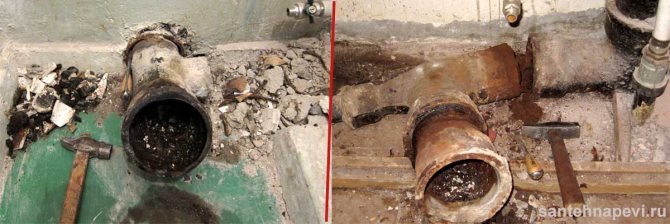

The main difficulty is, basically, the removal of the tee, stamped directly into the tee of the common fan riser, as, in most cases, only it is assembled with the use of sulfur, and even the transition is a bottle from 100 to 50, poured into the tee. This is a standard factory blank to facilitate and speed up the assembly process during construction. Further, a fifty-kopeck comb was minted with a bobble and coated with cement mortar. Removing the cast iron tee is necessary for a number of reasons, such as: after laying the tiles on the floor, the floor level has risen and, therefore, it is not possible to combine the cast iron socket of the fan tee with the toilet bowl outlet, also, when installing the toilet bowl into an existing tee, the toilet bowl moves too far from the wall , which is not a permissible luxury in our cramped apartment conditions, as well as during redevelopment, when the toilet is moved to another place and the factory tee becomes simply unnecessary. And finally, to install a flush-mounted installation under a wall-hung toilet. Too many words, let's get down to business. Ask your upper neighbors not to drain anything into the sewer for half an hour, as the water flowing through the pipe will prevent the socket from heating (if you do not live on the top floor). We disassemble, break, cut off the entire fan comb after the tee with a grinder. We need to leave one tee, without any connections. We take a hammer and a chisel in our hands and clean the debris from the rasping socket. It may turn out to be filled with cement mortar, and, if possible, we knock down occasional surges of sulfur protruding beyond the bell. The more thoroughly you clean, the less you will have to breathe poison. AHTUNG! We do all work without fanaticism, the use of excessive force is useless. Sweep out the knocked down sulfur. Now, in fact, we are moving on to the heating process.A blowtorch, of course, allows work to be done in a shorter time - it gives a higher temperature, but requires more responsibility. Now a little about what awaits you.
Sulfur is a poisonous substance. Here, no respiratory protection will be superfluous, up to a gas mask. Surely you had to smell the "aroma" of a burning match. How's the fun? And this, after all, is minuscule in comparison with what you get when burning sulfur from the bell of a cast-iron sewer in a closed room, neglecting protective equipment. And the work must be done together, in case you are still "lucky" to inhale the poisonous vapors of sulfur and you lose control of your body (you feel bad), then, in this case, there will be someone to take you out into the fresh air. And burning sulfur (fire cannot be avoided) is a serious danger. It burns with a barely noticeable bluish flame so that in order to avoid a fire, control the situation, and burns received in contact with burning sulfur are very painful. But if, nevertheless, in spite of all the precautions you still had to inhale a portion of the poisonous vapors, then this is very unpleasant, but it can still be considered a positive experience - it will be easier to adapt in Hell. We warm the socket from which you need to remove the tee. It won't take long - sulfur is a fusible material. During the heating process, with our hand (be sure to work with gloves - the high temperature and even the burning and even molten sulfur give serious burns) we try to move the removed part, again without using excessive force. As soon as the sulfur has melted, the part will easily come out of the socket. Be careful when removing the removed fitting - molten sulfur may drip from it, as it is still hot. Sulfur droplets produce persistent, poorly removable stains. IN NO EVENT DO NOT DIP IN WATER AND DO NOT pour WATER, for the fastest cooling, both the working socket and the removed part. Cast iron does not like sudden changes in temperature and cracks are guaranteed to you, on top of that, you can also get a splinter flying off your forehead. It is done.
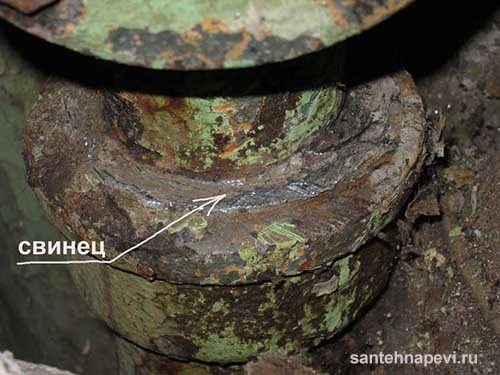

Let's talk now about the caulking of a socket filled or caulked with lead. The same trick as gray will not work here. Lead is a more refractory material. Only an oxygen-acetylene cutter will help to melt lead in a cast iron funnel of a fan pipe, but here the danger of overheating and the associated formation of cracks from strong temperature deformation of cast iron increases. And in general, the lead-minted fan system is found only in the old fund, where the sewer riser often runs along the wooden partitions and comes into contact with them in a dense manner. In such conditions, an open fire is out of the question. There is a way to get this job done in a completely peaceful, safe way. For this I use an electric drill and long drills, about 5 mm in diameter. I drill around the lead in the socket as far as I can get and try to shake it slightly - to loosen the stamped fitting in the socket. In most cases, this turns out to be enough to extract the sewer part, but if not enough, then we again take the drill and the bit thicker, as far as the gap between the socket and the removed part allows, and continue drilling. We help drilling with a screwdriver, removing (picking out) available lead residues from the socket. Work hard and you will be rewarded. When disassembling a fan connection, minted with a bondage and coated with cement mortar, one has to hope only for a miracle. Using a hammer, chisel or screwdriver, we clean the working socket from the cement coating and try to loosen it, again, without fanaticism. Sometimes a miracle happens in the form of a bondage turned into dust from time to time. In this case, just gently loosen and remove the unnecessary part from the socket.If the miracle does not happen, we take a screwdriver, a chisel, a hacksaw blade, a hammer and, as well, other tools that you yourself deem necessary and we begin to extract (pick out) the remnants of the cabal from the socket, from time to time shaking the extracted sewer part - suddenly it will give in. You won't be able to burn out or drill the cabal, although you can try it for the sake of gaining experience.
A few more words about the man-made miracle. Sometimes it is not possible to use not only open fire, but also some other heating device for caulking a socket filled with sulfur. Such a situation, sometimes, develops in the event that someone from the tenants of this apartment suffers from allergies and poisonous sulfur fumes from heating can provoke a critical situation. In this case, for caulking the socket, we use a hammer and a screwdriver as a chisel, as in the previous version. You can try drilling if there are small diameter drills that are long enough. It is necessary to start removing sulfur, necessarily, from the upper part of the bell, as after removing sulfur from the lower part of the bell, water will begin to flow into the entire depth into the gap formed, and while you then remove sulfur from the upper part of the bell, you will fill the apartment. Neighbors will not refrain from using the sewage system for 1.5 - 2 hours (the average time for this work), as in the case of using heating - 30 minutes. Patience and perseverance and a miracle will happen. That seems to be the whole science. In conclusion, all the same, I want to repeat once again: do not take on this work yourself - it is better to entrust it to a professional. There are many other works related to the arrangement of your apartment. Listen to the voice of reason. In plumbing, there is no more laborious, tedious and unpleasant job than working with funnel pipes. Ugh at her!
PVN
How to mint
Caulking is a procedure for sealing, sealing a connecting element. It is necessary to prepare materials, tools:
- oiled rope (hemp strand);
- cement (or asbestos-cement) mortar;
- a wooden spatula that fits freely into the gap of the socket;
- long screwdriver;
- a hammer.
The capping of the sockets of the sewer pipes takes place in 2 stages:
- stuffing the gap with tow or rope (cable). Using a cord is considered a more efficient option. The sealant is inserted into the gap, they begin to wind on the pipe, constantly ramming it with a spatula. The material must be compacted and immersed in the gap until it stops. The process is stopped when the gap is filled to 2/3 of the depth;
- cement mortar is poured into the gap over the seal. It is pushed with a wooden spatula or screwdriver, evenly distributing the material over the entire volume of the cavity. The quantity should be such that the entire gap is completely filled up to the very top of the socket.
Causing the bell with gray is not practiced at home. It is necessary to melt lump sulfur with 10-15% kaolin, which requires special equipment and enhanced ventilation. This method is only possible in the factory.

